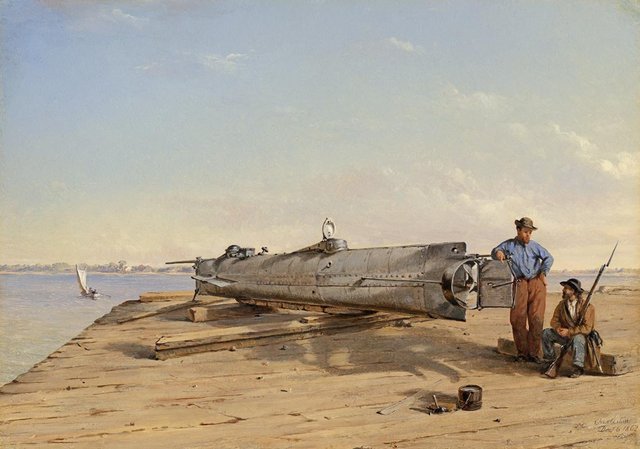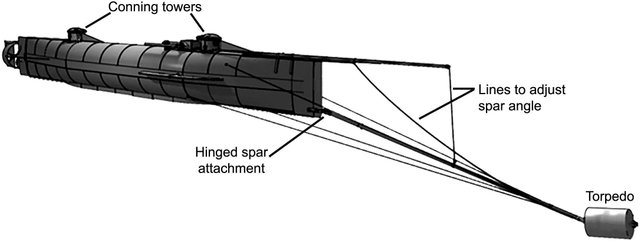Piqued Lite - The Awesome, Tragic Story Of The First Successful Ironclad Submarine, The H.L. Hunley, And The New Research That Explains It's Mysterious Demise

This is the H.L Hunley
War can be a driver of human innovation, and civil wars are no exception. Our desire to one-up each other's capacity for killing knows no bounds.
Take the American Civil War. The Union and the Confederacy are embroiled in conflict, on land and on sea. The first iron clad, armored vessels are being designed and deployed by both sides. But it is the South which first accomplishes something frighteningly new - both to its crew and the sailors it opposes - the fully submerged ship, or submarine.
The H.L. Hunley was first built in July 1863 and crewed with a small group of several conspicuously brave sailors. Unfortunately for those steadfast souls, the Hunley's road was bumpy.
In August 1863, the ship sank, killing 5 crew members. Then it was dredged, re-crewed, this time with the inventor, Mr. Hunley himself onboard, and redeployed - only to sink once again, this time killing everybody on board, Mr. Hunley included.
Third times the charm
On its third voyage, after another dredging and another crew, the Hunley set out in search of a target. It stayed afloat long enough to find one this time - the USS Housatonic, a sloop in the process of blockading Charleston harbor.
In the end, the Hunley successfully honed in on its target and utilized a "torpedo" to assault the Housatonic below the waterline, sinking the ship. Unfortunately for the Hunley, this procedure also caused the Hunley to sink with all crew aboard.
The Hunley's attack was not meant to he a suicide mission (although you'd be forgiven for thinking so). The ship was intended to be capable of repeated attacks, like a more advanced u-boat in the future. But instead it sunk right after its first assault, in deep water, and without definitive explanation. Until now.
New research in PLOS One has investigated the final sinking of the Hunley, in satisfying detail, and drawn some concrete conclusions.

First, you need to know that the Hunley was not a modern U-boat - and "torpedo" technology was... well...less than ideal. The Hunley, and other submarines like it, were essentially ramming ships.
The explosive torpedo was not fired out of the ship but held on the end of a long ramming rod. The Hunley would race forward under water and ram the torpedo into its target, blowing it up. Take a look at the figure from the open source research article to the left for an illustration.
Second, unlike other submerged ships, the Hunley was clad in iron instead of being made exclusively out of wood. This was intended both to provide better protection and to allow the ship to sit lower in the water, reducing its visibility.
Because the researchers had access to the specifications of the Hunley ship and its payload at the time of its sinking, they were able to re-create the submarine, and its final explosive moments, at 1/6 scale and see exactly what happened.
A confluence of circumstances
It might seem obvious that a submarine with a bomb on the end of a stick would not fare well when the bomb went off. Except, according to the research paper, previous submarine models had successfully deployed their torpedoes and lived to tell the tale. What, then, was different about the Hunley?
Researchers created an iron replica of the original ship, at 1/6 scale, and submerged it in a fresh water lake, at a depth about 1/6 scale. Then they did tests with explosive devices, ranging from 1/6 to 1/5 scale of the original explosive torpedo.
These test explosives were held at the appropriate 1/6 scale distance from the scale submarine, submerged in the lake. The scale model ship was filled with mylar pressure readers throughout its length, which test whether the PSI created by the explosion would be sufficient to kill human beings, like in Mythbusters!
Finally, when everything was prepared, several explosive tests were conducted.
Devastating results.
What the researchers found was that every explosive test resulted in the "death" of 84% of the submarine's crew, with the remaining 16% being "severely injured" to the point of incapacity.
This was the result no matter where alongside the ship the explosion occurred. Whether in front or on the side of the ship, the pressure waves from the explosion radiated with equal strength throughout the ships tight confines.
The question is, why did the Hunley experience this devastating self harm when other submarines did not? The answer is multifaceted:
First, the ship was made of wrought iron, which apparently was much better at transmitting the pressure waves of the explosion than the previous material used, plain old wood.
Second, the ship's lower depth in the water apparently also facilitated the propogation of the explosive pressure into the ship.
Third, perhaps because they thought the metal armor would protect the ship, the "torpedo" was attached to a 5 meter prong, significantly shorter than prior designs.
The result: when the Hunley rammed the Housatonic and exploded its torpedo, the explosive waves of pressure traveled cleanly through the Hunley's iron hull and into its sailors. It probably was not enough pressure to toss crew members bodily across the ship, but more than enough to destroy organs. More than likely the great majority of the crew would have been killed by the blast. Those unlucky enough to survive were gravely injured, unlikely to move or breath, as they floated to the bottom of the bay in darkness.
A harrowing tale, and an awesome piece of explosive research.
Support the SteemSTEM project - curating and supporting quality STEM relaed content on STEEMIT.
Information Source:
[1]Air blast injuries killed the crew of the submarine H.L. Hunley Lance RM, Stalcup L, Wojtylak B, Bass CR (2017) Air blast injuries killed the crew of the submarine H.L. Hunley. PLOS ONE 12(8): e0182244.
[2]Wikipedia page for some other details of the Hunleys early deployment
Photo Sources:
[1]Conrad Wise Chapman, American Painter, public domain, wikimedia commons
[2]Figure 1 from open source PLOS One paper cited to above.
One of my former colleagues had a shirt that said "H. L. Hunley Dive Team" on it. I thought it was a joke, like "Titanic Swim Club." He seemed a little bit offended.
Turns out he participated in the 2000 project to raise the Hunley. He might have written about it in this book: https://www.amazon.com/Trial-Fire-Science-Technology-Civil/dp/157249185X
I can't remember and I gave my copy to my dad. You might like the book. One of the more memorable stories is about the technologies that the Union Army used to dig a tunnel under the Confederate lines at Petersburg. At the time is was the longest tunnel every made without air vents.
Haha - no offense to your friend - but that is a superbly witty t-shirt - so much so I may need to have one custom made.
I wonder if there is a copy of that book in the NYPL
Great post, a few months ago had read the history of this "submarine" that had been designed more than 150 years ago in the civil war and released recently, the analysis you do is very good and complete, it is incredible with the time Technology that had at that time what they could create! Thank you very much for sharing and I hope to continue finding posts of this type! Greetings.
Thanks for reading - it was a pretty incredible achievement that the submarine functioned at all, let alone that it was able to destroy another ship. What blows me away is that anyone was willing to get on board the third and final time, after two previous crews were both drowned. Who does that?!
LOL always believe that the problems are corrected, they were pieneron and gave their life for the evolution, because thanks to those life was perfected, as the first article says they were made of wood but they went further and made it steel.
That inventor had some courage to go on the 2nd submarine... he must have really believed that one was going to work. Too bad about that.
Yeah - the power of his convictions didn't do much at the bottom of the harbor I guess. Definitely sucks. Everybody who got into that thing after the first sinking is ridiculously courageous
Congratulations! This post has been upvoted from the communal account, @minnowsupport, by DBER from the Minnow Support Project. It's a witness project run by aggroed, ausbitbank, teamsteem, theprophet0, someguy123, neoxian, followbtcnews/crimsonclad, and netuoso. The goal is to help Steemit grow by supporting Minnows and creating a social network. Please find us in the Peace, Abundance, and Liberty Network (PALnet) Discord Channel. It's a completely public and open space to all members of the Steemit community who voluntarily choose to be there.
This post has received a 0.35 % upvote from @drotto thanks to: @banjo.